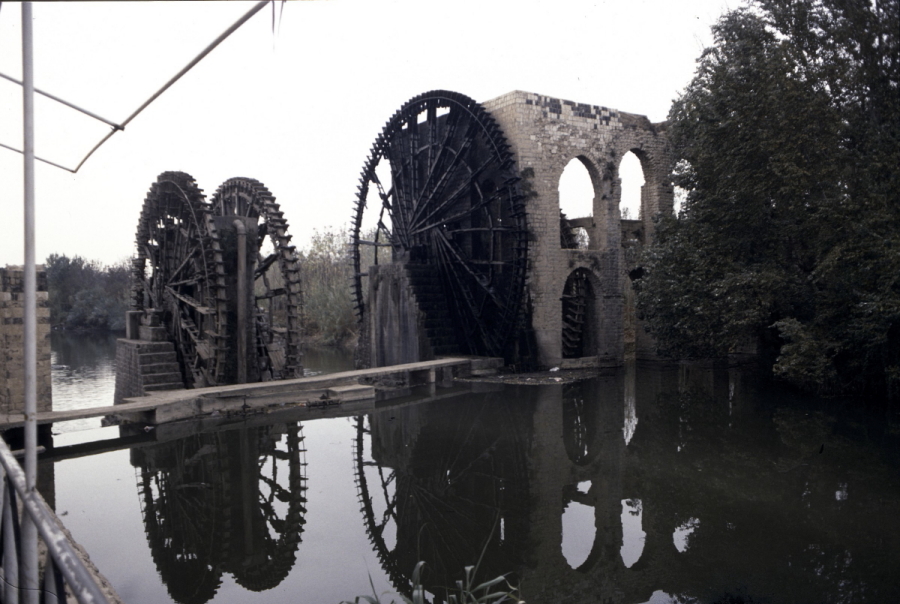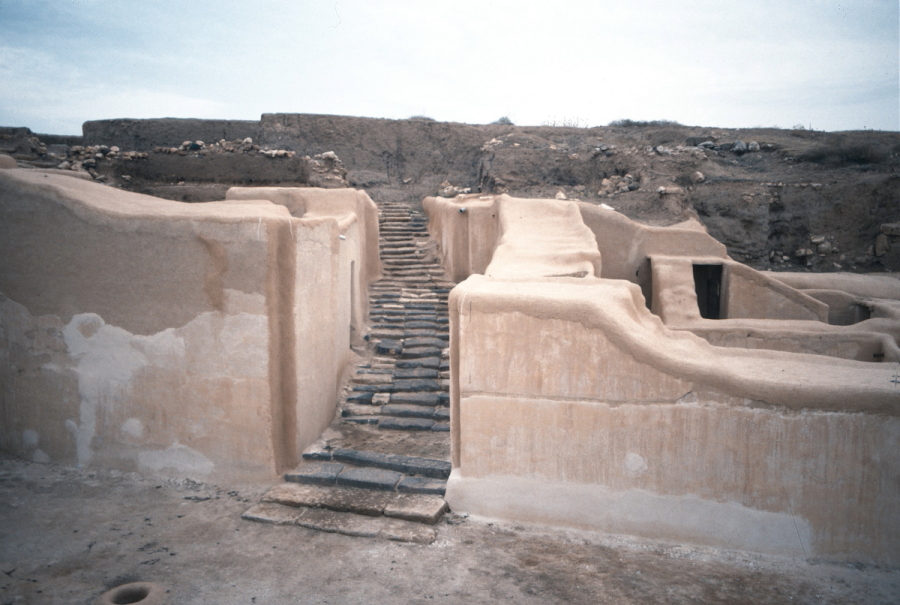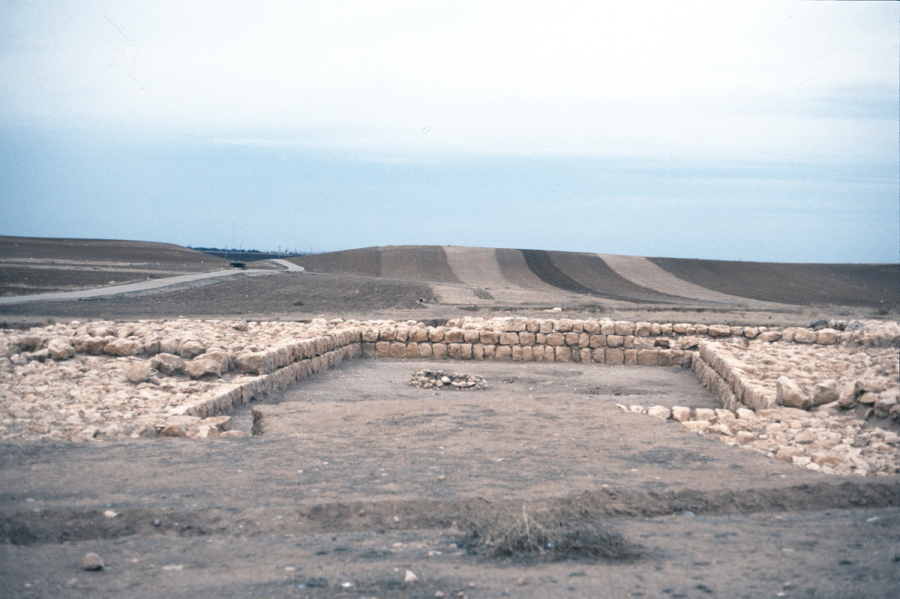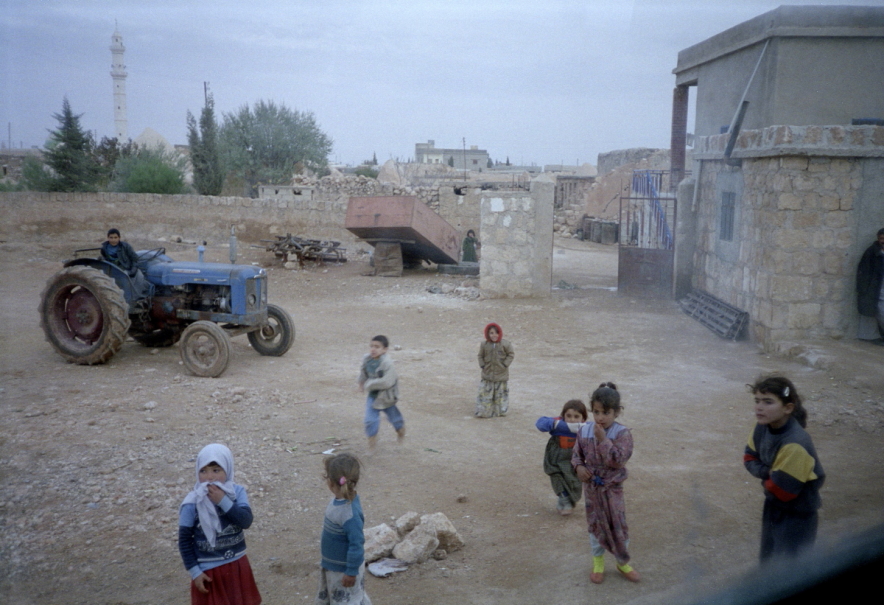Tuesday 30th November 1993, 10:00am - 4:30pm
We look out from the window of the coach as we drive from Palmyra to Homs. We appear to be driving through a desert. Here and there we see Bedouin tents and men out with flocks of sheep. The ground looks barren to my inexperienced eyes but the sheep are busy grazing. There must be enough to feed them, at least today. Maybe they move on tomorrow. I wonder what the shepherds are thinking about as they sit overlooking their sheep. I don't think I could cope with the boredom.
A pipeline, marked by orange posts, is running along side the road. The guide tells us it was the Iraq Petroleum Company (Iraq National Oil Company after 1972 nationalisation) pipeline, crossing the country from the Iraq border through to the Mediterranean coast. He tells us that it hasn't been used since 1982 when when Syria sided with Iran during the Iran-Iraq war, a war which ended only a couple of years before Iraq invaded Kuwait and provoked the recent Gulf War.
As we travel closer to Homs the desert gradually gives way to more arable land. Once again we see that everywhere that can be cultivated is cultivated, planted with olive and pistachio trees or ploughed ready for the next crop. Not a square centimetre wasted! The closer we get to Homs the more green it becomes; now almond and cypress trees are added into the mix. Apparently there is a gap in the mountains to the west through which moisture laden wind blows from the Mediterranean and consequently Homs has more rain than the surrounding areas.
We drive through Homs which appears to be a busy town. We don't stop and we don't see much but I get the impression our route is through a fairly affluent district. It certainly looks more affluent than the parts of Damascus we visited, but then we haven't yet seen much of either. We need to be in Hama in time for lunch.
A short stop in Hama for lunch and a quick walk to see the many large wooden water wheels which used to lift the water from the river into the aqueducts leading to the irrigation systems. These days the wheels are for show, and electric or diesel powered pumps are used for feeding the irrigation systems.

While we are admiring and photographing the water wheels our guide tells us a little about the recent history of Hama. In 1982 there was an uprising against the government and many buildings were destroyed and thousands of people killed as the rebellion was crushed.
I learned later that a crack down by the Syrian government on Muslim Brotherhood insurgents based in the city triggered the uprising. The city was under heavy bombardment for three weeks and in the hunt for members of the brotherhood government militia killed thousands of innocent citizens. By the time the uprising was over and government forces crushed the rebellion parts of the city, including many historic buildings, were destroyed and many tens of thousands of people were killed. As evidence of what took place emerged it was described as a massacre.
Back on the road heading north to Aleppo, the surrounding landscape is now of more fertile land. Dark clouds are gathering, it looks as though it could start raining any time. Strange to think that a few hours ago we were in the middle of a desert.
We stop at Ebla, the guide is keen to show us the site of extensive archeological excavations. He tells us there have been excavations here since the 1960s when a city dating to the 3rd millenium bc was found. More recently (1975) the archeologists uncovered a palace and in it thousands of clay tablets inscribed with detailed accounts of the daily lives, stories and legends of the time. Our guide has worked with the eminent Italian archeologist who made the discovery, which is claimed to be the most significant in the orient this century and he explains that the tablets were discovered as though catalogued and filed systematically in a library or archive.

We are standing on a mound overlooking part of the excavations. To be honest there is little to see from where I am standing and I am cold, but the guide is keeping us interested with his enthralling story and his clear delight at his personal involvement in this piece of history. The tablets, written in the cuneiform writing system, have now been deciphered and are currently being studied by a group of about 10 of the world's leading experts and he wonders whether they will contain any details which confirm bible stories.
Our guide could have talked about this for hours and it is clear that there is a lot more he could show us - he is spoiled for choice - but everyone now looks cold and the weather is threatening rain. He cuts short his stories about the ancient city, the tablets and the significance of their find and leads us a few metres further around the mound to where we can see some of the excavated buildings and look out across one part of the site. My fingers are almost too cold to use the camera, but this place is famous. I'm not likely to visit again soon so I must get a photograph!
I notice that the ploughed fields come right to the edge of the archeological site and two farmers are busy working not far from where we are standing. I am sure it will rain soon. It is clear that this area received a lot more rain than where we were this morning but there is still evidence of irrigation. Maybe the rain is seasonal.

Back on the coach, warmth starting to flow back into my hands, I watch a few local children gather around the coach. They must be used to visitors coming to this site. A couple of tractors but no cars are parked in the courtyard across from our coach. We haven't seen many private cars so far on our travels but we have seen a lot of tractors, often with trailers containing passengers. The guide has told us that most of the land we see being farmed is owned by the state and that agriculture tends to be centrally planned, not left to market forces, so I wonder whether the state also owns the tractors and employs the farmers.
Someone must have asked a question while I was gazing through the window feeling relieved to be warm again. I hear the guide saying that the state subsidises staple foods but he isn't sure whether that is a good thing or not. He tends to think it is not but worries what will happen to the poorest if the subsidies are ever stopped.
As we drive off on the last leg of our journey to Aleppo it begins to rain.
